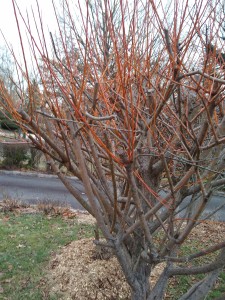 As they say in the movies, “We have a situation.”
As they say in the movies, “We have a situation.”
The situation in question is on the south side of my house, which is dark, dank and completely lacking in charm. I don’t like it and neither do the plants that live there. It has to be rectified.
The relatively narrow area between the side of my house and the neighbors’ driveway is defined by two large holly trees with English ivy and yellow archangel or Lamium lamiastrum covering the ground at their feet. A narrow path runs in front of them. On the other side of the path, close to the driveway, are a line of four rose of Sharon shrubs growing in tree form, and a large, yellow-flowered magnolia tree. The area between the magnolia/roses of Sharon and the path contains a trio of rose bushes, underplanted with bigleaf geranium or Geranium macrorrhizum. Weeds, barberry seedlings, self-sown tree saplings and other marauders creep in from time to time to complicate the situation.
There are two solutions to this particular horticultural and aesthetic problem. The first, which is predicated on lots of cash, is to call a landscaper, provide explicit directions and stand back as limbs are removed, roses of Sharon and hollies are tamed, and weedy growth is yanked out. While that process takes place, I could put on a headset and get to work on a book about garden perfection.
The second solution, which is predicated on time and sweat, is to take the tool basket and do it myself. The book will have to wait.
I have started on the second solution.
Letting in light is key to the survival of the smaller plants, so I started by limbing up the magnolia, excising a couple of low limbs with my pruning saw. Once the offending branches were down and their remains chopped and bagged, I started on the roses of Sharon, which need severe pruning after a two-year period when they have been left to their own vigorous devices.
“Severe pruning” means reducing their height and volume by about two thirds, so they look as if they were planted deliberately instead of being the offspring of a single, wildly self-seeding parent. This requires a little work with the pruning saw and a lot of work with sturdy garden loppers. It also requires a number of lawn and leaf bags. Next year I vow to get a mall chipper shredder to reduce this kind of debris to mulch.
The roses of Sharon continue to be a work in progress. Next on the agenda is ‘Alister Stella Gray’, a small-flowered yellow rambling rose that blooms gloriously and prolifically once a year in the spring and works at growing to monumental proportions year round. ‘Alister’ has typical rambler traits, which include long, flexible canes that sprout from the main stems in all directions. Unchecked, ‘Alister’ will produce canes that are up to eight or more feet long, traveling wherever they want and frequently rooting when they touch the ground. ‘Alister’ is set for restoration pruning, which means that all those aggressive canes will disappear, and the plant will be about 12 inches tall at the end of the process. Needless to say, pruning a rose that long ago escaped its defined boundaries will be thorny business, requiring heavy rose gauntlets, clippers, loppers, infinite patience and a good supply of band-aids and antiseptic cream.
The hollies also need pruning, to keep them from projecting out over the path and casting unwanted shade. Since they are sturdy trees that have grown up to the top of the house, I can only get to the lower limbs. Still, many of the overhanging branches are accessible via stepstool or ladder, and I can make a considerable difference in the shade situation as long as I don’t have any dizzy spells.
If I happen to have a dizzy spell, I will cease the holly pruning, hydrate with at least a quart of water and tackle the weeds and barberry sprouts at ground level.
When all of that heavy work is done, I will be able to get down to the business of taming the ground covers, and pruning the two striped roses that have grown leggy in their search for the little available light. I’ll sweep up the nearly indestructible holly leaves that currently cover the path and use them to mulch the holly trunks.
At the end of the entire process, I will relax and make two resolutions. Once will be to keep up with the routine pruning every year, so the situation does not repeat itself. The other is to save my pennies, so the tree company can come and tame the upper reaches of the hollies. At least my hard work will have provided the tree people with a clear space from which to stage their ladders, and eliminated the dire prospect of one or more of them becoming painfully entwined in the clinging and prickly embrace of ‘Alister Stella Gray’.
